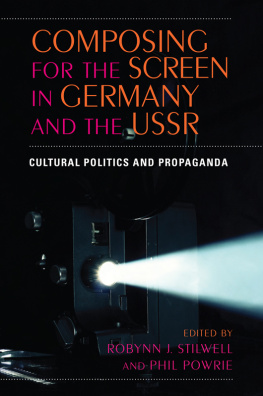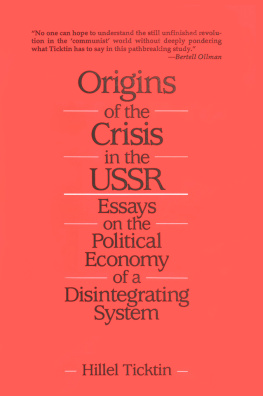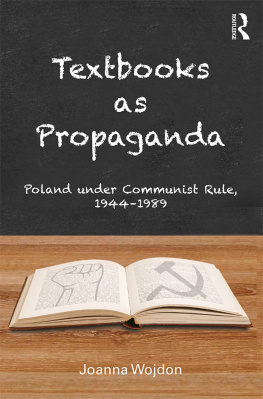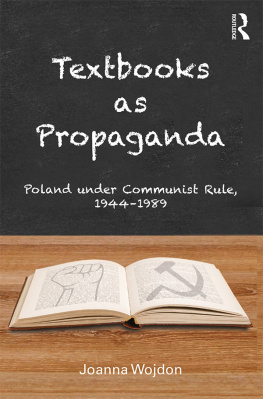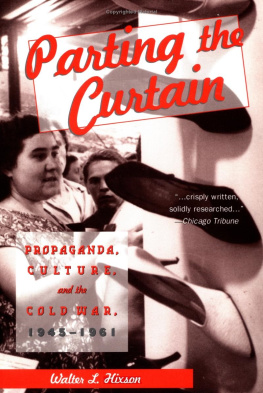THE YALE-HOOVER SERIES ON STALIN, STALINISM, AND THE COLD WAR
Propaganda State in Crisis
SOVIET IDEOLOGY, INDOCTRINATION, AND TERROR UNDER STALIN, 19271941
DAVID BRANDENBER GER
Hoover Institution
Stanford University
Stanford, California
Yale UNIVERSITY PRESS
New Haven and London
Published with assistance from the foundation established in memory of Philip Hamilton McMillan of the Class of 1894, Yale College.
Copyright 2011 by Yale University and the Board of Trustees of the Leland Stanford Jr. University.
All rights reserved.
This book may not be reproduced, in whole or in part, including illustrations, in any form (beyond that copying permitted by Sections 107 and 108 of the U.S. Copyright Law and except by reviewers for the public press), without written permission from the publishers.
Yale University Press books may be purchased in quantity for educational, business, or promotional use. For information, please e-mail sales.press@yale.edu (U.S. office) or sales@yaleup.co.uk (U.K. office).
Set in Sabon Roman type by Vondas Comp Services.
Printed in the United States of America.
Library of Congress Cataloging-in-Publication Data
Brandenberger, David.
Propaganda state in crisis: Soviet ideology, indoctrination, and terror under Stalin, 19271941 / David Brandenberger.
p. cm. (The Yale-Hoover series on Stalin, Stalinism, and the Cold War)
Includes bibliographical references and index.
ISBN 978-0-300-15537-2 (pbk.: alk. paper)
1. Propaganda, SovietHistory. 2. Stalin, Joseph, 18791953Influence. 3. Kommunisticheskaia partiia Sovetskogo SoiuzaHistory. 4. Political cultureSoviet Union History. 5. Popular cultureSoviet UnionHistory. 6. Public opinionSoviet Union History. 7. IdeologySoviet UnionHistory. 8. State-sponsored terrorismSoviet UnionHistory. 9. Soviet UnionPolitics and government19171936. 10. Soviet UnionPolitics and government19361953. I. Title.
DK269.5.B73 2011
947.0842dc22
2011014928
A catalogue record for this book is available from the British Library.
This paper meets the requirements of ANSI/NISO Z39.48-1992 (Permanence of Paper).
10 9 8 7 6 5 4 3 2 1
To Sasha, Fedya, and Katia
Contents
List of Illustrations
Acknowledgments
This study has benefited from a number of long-and short-term grants provided by the International Research and Exchanges Board (IREX), with funds supplied by the National Endowment for the Humanities and the United States Department of State under the auspices of the Russian, Eurasian, and East European Research Program (Title VIII); the National Endowment for the Humanities; the Department of States Fulbright Program; the Davis Center for Russian and Eurasian Studies at Harvard University; and the School of Arts and Sciences at the University of Richmond.
The origins of this study date back to the mid-1990s when I looked into the origins of Stalins infamous Short Course in the former central party archive in Moscow before setting the topic aside as prohibitively difficult. Aspects borrow from chapter two of my book National Bolshevism: Stalinist Mass Culture and the Formation of Modern Russian National Identity, 19311956 (Copyright 2002 by the President and Fellows of Harvard College) and chapter thirteen of Sarah Davies and James Harriss 2005 edited volume Stalin: A New History. I would like to thank Harvard University Press and Cambridge University Press for their permission to reprint portions of these pieces. I would also like to acknowledge my gratitude to friends and colleagues who have read and commented upon aspects of this manuscriptM. V. Zelenov, Serhy Yekelchyk, George Enteen, Erik van Ree, Peter Blitstein, Katia Dianina, Eric Lohr, and David Hoffmann. Discussions with A. M. Dubrovsky, David Priestland, Polly Jones, and Sandra Dahlke came at important junctures, as did collaborative work on the Harvard Project on the Soviet Social System with Terry Martin and on the Short Course with Zelenov. At Yale University Press, Jonathan Brent and Vadim Staklo provided critical support and Margaret Otzel and Kay Scheuer guided the manuscript into print. But I am most grateful to Sasha, Fedya, and Katia for their good humor, and it is to them that this work is dedicated.
A Note on Conventions
The transliteration of terms, titles, surnames, and geographic locations herein adhere to Yale University Presss house style. Exceptions occur in quotations taken from other sources and in the bibliographic citations, which follow the transliteration conventions practiced by the U.S. Library of Congress. Geographic and geopolitical names and spellings used here are those appropriate for a study of the 1930s even if theyve changed in recent years (Leningrad, not St. Petersburg; Belorussia, not Belarus; Kiev, not Kyiv). In order to improve readability, frequent terms like the Party are not capitalized in the text. For similar reasons, French calques like etatist and English constructions like party hierarchy are used instead of anglicizing Russian colloquialisms like gosudarstvennik and partiinaia verkhushka.
Terms and Acronyms
For a complete list of the terms, historical events, and personalities referred to in this volume, see the index.
ACP(b) | All-Union Communist Party (Bolsheviks) |
Agitprop | Central Committee Directorate of Agitation and Propaganda |
Glavlit | Main Committee on State Censorship |
Glavpolitprosvet | Main Political Education Committee |
IKP | Institute of the Red Professors |
IMEL | Marx-Engels-Lenin Institute |
komsomol
Cheka | communist youth league |
NKVD
OGPU | various incarnations of the secret police |
Osoaviakhim | Society for the Support of Aviation and the Chemical Industry |
Politburo | Central Committee Political Bureau |
RAPP | Russian Association of Proletarian Writers |
RSFSR | Russian Soviet Federative Socialist Republic |
Sovnarkom | All-Union Council of Peoples Commissars |
SRs | Socialist-Revolutionary Party |
Introduction: Ideology, Propaganda, and Mass Mobilization
THE USSR UNDER LENIN AND STALIN is often referred to as the worlds first propaganda state. That said, if ideology, propaganda, and mass indoctrination are often considered key characteristics of the Soviet experiment, theyve received surprisingly little scholarly attention in recent years. Although many early Sovietologists looked to ideology to explain virtually all the idiosyncrasies of this state and society, This book returns ideology to center stage by revealing the scale and uniqueness of the party hierarchys engagement with propaganda and indoctrination, as well as the extent to which Stalin and his entourage personally participated in the creation of the official line and party canon.
Authoritarian and ruthless, Stalin and his inner circle were also true believers living in what they believed to be an ideologically charged world.that an understanding of their historical experience was fundamental to Soviet citizens formation of a distinctive sense of self. Untold resources were to be devoted to the task of indoctrination, whether through propaganda, education, or mass culture. Still more was to be spent purging the Soviet public sphere of any material that might contradict the official line. Ultimately, the propaganda campaigns of the 1930s that climaxed with the publication of the infamous
Next page


